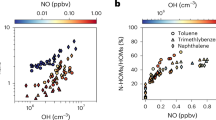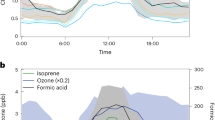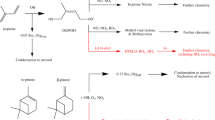Abstract
Reactive organic carbon species are important fuel for atmospheric chemical reactions, including the formation of secondary organic aerosol. However, in parallel to atmospheric oxidation processes, deposition can remove compounds from the atmosphere and impact downstream environments. To understand the impact of deposition on atmospheric oxidation, we present a framework for predicting and visualizing the fate of a molecule on the basis of the physicochemical properties of compounds (Henry’s law constant, vapour pressure and reaction rate constants), which are used to estimate timescales for oxidation and deposition. By implementing our deposition rates in chemical models, we show that deposition substantially suppresses atmospheric reactivity and aerosol formation by removing early-generation products and preventing the formation of large fractions (up to 90%) of downstream, late-generation compounds. Deposition is frequently missing in the laboratory experiments and detailed chemical modelling, which probably biases our understanding of atmospheric composition.
This is a preview of subscription content, access via your institution
Access options
Access Nature and 54 other Nature Portfolio journals
Get Nature+, our best-value online-access subscription
$32.99 / 30 days
cancel any time
Subscribe to this journal
Receive 12 print issues and online access
$259.00 per year
only $21.58 per issue
Buy this article
- Purchase on SpringerLink
- Instant access to full article PDF
Prices may be subject to local taxes which are calculated during checkout






Similar content being viewed by others
Data availability
The lifetimes and physicochemical properties of the compounds shown in Fig. 2 and ~140,000 additional compounds are publicly available via Mendeley (https://doi.org/10.17632/3rgvkf7c9n) (ref. 27). The compounds used in the chemically explicit modelling are freely available through the Master Chemical Mechanism (https://mcm.york.ac.uk/MCM/) and referenced publicly available works. Deposition lifetimes for all compounds used in the chemically explicit box model are provided as Supplementary Dataset 1. These data and the referenced publicly available models were used to generate Figs. 3, 5 and 6 and Extended Data Figs. 2–4. All information to generate Figs. 1 and 4 is described in Methods and Supplementary Information. Source data are provided with this paper.
Code availability
Models used in this work are publicly available as cited. The F0AM model was used as provided, with additional reactions added as described in the article and Supplementary Information. The SimpleSOM model was modified slightly to include deposition as described in the article; the modified code has been provided to the authors of the model for inclusion in their next publicly available release.
References
Burnett, R. T. et al. An integrated risk function for estimating the global burden of disease attributable to ambient fine particulate matter exposure. Environ. Health Perspect. 122, 397–403 (2014).
Heald, C. L. & Kroll, J. H. The fuel of atmospheric chemistry: toward a complete description of reactive organic carbon. Sci. Adv. 6, eaay8967 (2020).
Jin, L. et al. Constraining emissions of volatile organic compounds from western US wildfires with WE-CAN and FIREX-AQ airborne observations. Atmos. Chem. Phys. 23, 5969–5991 (2023).
Guenther, A. B. et al. The Model of Emissions of Gases and Aerosols from Nature version 2.1 (MEGAN2.1): an extended and updated framework for modeling biogenic emissions. Geosci. Model Dev. 5, 1471–1492 (2012).
Murphy, B. N. et al. Reactive organic carbon air emissions from mobile sources in the United States. Atmos. Chem. Phys. 23, 13469–13483 (2023).
Mattila, J. M. et al. Contrasting chemical complexity and the reactive organic carbon budget of indoor and outdoor air. Environ. Sci. Technol. 56, 109–118 (2022).
McDonald, B. C. et al. Volatile chemical products emerging as largest petrochemical source of urban organic emissions. Science 359, 760–764 (2018).
Seltzer, K. M. et al. Reactive organic carbon emissions from volatile chemical products. Atmos. Chem. Phys. 21, 5079–5100 (2021).
Isaacman-Vanwertz, G. et al. Chemical evolution of atmospheric organic carbon over multiple generations of oxidation. Nat. Chem. 10, 462–468 (2018).
Goldstein, A. H. & Galbally, I. E. Known and unexplored organic constituents in the Earth’s atmosphere. Environ. Sci. Technol. 41, 1514–1521 (2007).
Aumont, B., Szopa, S. & Madronich, S. Modelling the evolution of organic carbon during its gas-phase tropospheric oxidation: development of an explicit model based on a self generating approach. Atmos. Chem. Phys. 5, 2497–2517 (2005).
Bi, C. & Isaacman-VanWertz, G. Estimated timescales for wet deposition of organic compounds as a function of Henry’s law constants. Environ. Sci. Atmos. 2, 1526–1533 (2022).
Hodzic, A. et al. Volatility dependence of Henry’s law constants of condensable organics: application to estimate depositional loss of secondary organic aerosols. Geophys. Res. Lett. 41, 4795–4804 (2014).
Isaacman-VanWertz, G. & Aumont, B. Impact of organic molecular structure on the estimation of atmospherically relevant physicochemical parameters. Atmos. Chem. Phys. 21, 6541–6563 (2021).
Safieddine, S. A., Heald, C. L. & Henderson, B. H. The global nonmethane reactive organic carbon budget: a modeling perspective. Geophys. Res. Lett. 44, 3897–3906 (2017).
Pye, H. O. T. et al. Linking gas, particulate, and toxic endpoints to air emissions in the Community Regional Atmospheric Chemistry Multiphase Mechanism (CRACMM). Atmos. Chem. Phys. 23, 5043–5099 (2023).
Carter, W. P. L. Development of the SAPRC-07 chemical mechanism. Atmos. Environ. 44, 5324–5335 (2010).
Sarwar, G. et al. A comparison of atmospheric composition using the Carbon Bond and Regional Atmospheric Chemistry Mechanisms. Atmos. Chem. Phys. 13, 9695–9712 (2013).
Donahue, N. M., Epstein, S. A., Pandis, S. N. & Robinson, A. L. A two-dimensional volatility basis set: 1. Organic-aerosol mixing thermodynamics. Atmos. Chem. Phys. 11, 3303–3318 (2011).
Kroll, J. H. et al. Carbon oxidation state as a metric for describing the chemistry of atmospheric organic aerosol. Nat. Chem. 3, 133–139 (2011).
Heald, C. L. et al. A simplified description of the evolution of organic aerosol composition in the atmosphere. Geophys. Res. Lett. 37, L08803 (2010).
Cappa, C. D. & Wilson, K. R. Multi-generation gas-phase oxidation, equilibrium partitioning, and the formation and evolution of secondary organic aerosol. Atmos. Chem. Phys. 12, 9505–9528 (2012).
Pankow, J. F. & Barsanti, K. C. The carbon number–polarity grid: a means to manage the complexity of the mix of organic compounds when modeling atmospheric organic particulate matter. Atmos. Environ. 43, 2829–2835 (2009).
Estimation Programs Interface Suite for Microsoft Windows v.4.11 (EPA, 2012).
Compernolle, S., Ceulemans, K. & Müller, J. F. EVAPORATION: a new vapour pressure estimation method for organic molecules including non-additivity and intramolecular interactions. Atmos. Chem. Phys. 11, 9431–9450 (2011).
Nguyen, T. B. et al. Rapid deposition of oxidized biogenic compounds to a temperate forest. Proc. Natl Acad. Sci. USA 112, E392–E401 (2015).
Isaacman-VanWertz, G. & Aumont, B. SMILES and Physicochemical Parameters—Pinene, Decane, Toluene Oxidation Products v.2 (Mendeley Data, 2021).
Wolfe, G. M., Marvin, M. R., Roberts, S. J., Travis, K. R. & Liao, J. The Framework for 0-D Atmospheric Modeling (F0AM) v3.1. Geosci. Model Dev. 9, 3309–3319 (2016).
Pye, H. O. T. et al. Anthropogenic enhancements to production of highly oxygenated molecules from autoxidation. Proc. Natl Acad. Sci. USA 116, 6641–6646 (2019).
Li, J. et al. Observational constraints on glyoxal production from isoprene oxidation and its contribution to organic aerosol over the southeast United States. J. Geophys. Res. Atmos. 121, 9849–9861 (2016).
Zhu, Y. et al. Multiphase MCM–CAPRAM modeling of the formation and processing of secondary aerosol constituents observed during the Mt Tai summer campaign in 2014. Atmos. Chem. Phys. 20, 6725–6747 (2020).
Jathar, S. H. et al. A computationally efficient model to represent the chemistry, thermodynamics, and microphysics of secondary organic aerosols (simpleSOM): model development and application to α-pinene SOA. Environ. Sci. Atmos. 1, 372–394 (2021).
Knote, C., Hodzic, A. & Jimenez, J. L. The effect of dry and wet deposition of condensable vapors on secondary organic aerosols concentrations over the continental US. Atmos. Chem. Phys. 15, 1–18 (2015).
Ng, N. L. et al. Contribution of first- versus second-generation products to secondary organic aerosols formed in the oxidation of biogenic hydrocarbons. Environ. Sci. Technol. 40, 2283–2297 (2006).
Witkowski, B., Al-Sharafi, M., Blaziak, K. & Gierczak, T. Aging of alpha-pinene secondary organic aerosol by hydroxyl radicals in the aqueous phase: kinetics and products. Environ. Sci. Technol. 57, 6040–6051 (2023).
Marais, E. A. et al. Aqueous-phase mechanism for secondary organic aerosol formation from isoprene: application to the southeast United States and co-benefit of SO2 emission controls. Atmos. Chem. Phys. 16, 1603–1618 (2016).
Knote, C. et al. Simulation of semi-explicit mechanisms of SOA formation from glyoxal in aerosol in a 3-D model. Atmos. Chem. Phys. 14, 6213–6239 (2014).
Shen, X., Zhao, Y., Chen, Z. & Huang, D. Heterogeneous reactions of volatile organic compounds in the atmosphere. Atmos. Environ. 68, 297–314 (2013).
Lin, Y. H. et al. Isoprene epoxydiols as precursors to secondary organic aerosol formation: acid-catalyzed reactive uptake studies with authentic compounds. Environ. Sci. Technol. 46, 250–258 (2012).
Kroll, J. H., Ng, N. L., Murphy, S. M., Flagan, R. C. & Seinfeld, J. H. Secondary organic aerosol formation from isoprene photooxidation. Environ. Sci. Technol. 40, 1869–1877 (2006).
Kroll, J. H. & Seinfeld, J. H. Chemistry of secondary organic aerosol: formation and evolution of low-volatility organics in the atmosphere. Atmos. Environ. 42, 3593–3624 (2008).
Ng, N. L. et al. Secondary organic aerosol formation from m-xylene, toluene, and benzene. Atmos. Chem. Phys. 7, 3909–3922 (2007).
Wang, N., Jorga, S. D., Pierce, J. R., Donahue, N. M. & Pandis, S. N. Particle wall-loss correction methods in smog chamber experiments. Atmos. Meas. Tech. 11, 6577–6588 (2018).
Zhang, X. et al. Influence of vapor wall loss in laboratory chambers on yields of secondary organic aerosol. Proc. Natl Acad. Sci. USA 111, 5802–5807 (2014).
Weseley, M. L. Parameterization of surface resistances to gaseous dry deposition in regional-scale numerical models. Atmos. Environ. 23, 1293–1304 (1989).
Estimation Programs Interface Suite for Microsoft Windows v.4.1 (EPA, 2015).
Kwok, E. S. C. & Atkinson, R. Estimation of hydroxyl radical reaction rate constants for gas-phase organic compounds using a structure-reactivity relationship: an update. Atmos. Environ. 29, 1685–1695 (1995).
D’Ambro, E. L. et al. Isomerization of second-generation isoprene peroxy radicals: epoxide formation and implications for secondary organic aerosol yields. Environ. Sci. Technol. 51, 4978–4987 (2017).
Topping, D. et al. UManSysProp v1.0: an online and open-source facility for molecular property prediction and atmospheric aerosol calculations. Geosci. Model Dev. 9, 899–914 (2016).
Heald, C. L. et al. Contrasting reactive organic carbon observations in the southeast United States (SOAS) and Southern California (CalNex). Environ. Sci. Technol. 54, 14923–14935 (2020).
Chhabra P. S. et al. Application of high-resolution time-of-flight chemical ionization mass spectrometry measurements to estimate volatility distributions of α-pinene and naphthalene oxidation products. Atmos. Meas. Tech. 8, 1–18 (2015).
Acknowledgements
We appreciate J. Kroll for useful comments that improved this paper and thank B. Murphy, H. Pye, J. Bash and H. Foroutan for valuable scientific discussions on this topic. This work was supported by the Department of Energy Office of Biological and Environmental Research (DE-SC0022020, supporting G.I-V.W. and C.B.) and the National Science Foundation Atmospheric and Geospace Sciences CAREER programme (AGS-2046367, supporting G.I-V.W.).
Author information
Authors and Affiliations
Contributions
C.B. and G.I.-V.W. contributed equally to this work. C.B. performed data analysis and led model implementations and interpretation. G.I.-V.W. conceived the study, contributed to data analysis and conducted modelling. Both authors contributed substantially to writing and editing.
Corresponding author
Ethics declarations
Competing interests
The authors declare no competing interests.
Peer review
Peer review information
Nature Geoscience thanks the anonymous reviewers for their contribution to the peer review of this work. Primary Handling Editor: Tom Richardson, in collaboration with the Nature Geoscience team.
Additional information
Publisher’s note Springer Nature remains neutral with regard to jurisdictional claims in published maps and institutional affiliations.
Extended data
Extended Data Fig. 1 Sensitivity analysis of the deposition timescales to leaf area index (LAI).
Deposition timescale versus oxidation timescale for chemical species in F0AM is shown for a) LAI = 4.7 and b) LAI = 0.47. Markers are sized by relative concentration without deposition and colored by the normalized loss of concentration with and without the implementation of deposition (that is, Δconcentration(Dep-NoDep)/concentration(NoDep)) for simulated precursors and oxidants in the SOAS campaign at 3 hours of the simulation. The impact of transport to the free troposphere is not included here.
Extended Data Fig. 2 Impact of deposition on modeled oxidation by OH radicals.
Organic aerosol formation and product OH reactivity with and without deposition in modeled OH oxidation by in chemically explicit ‘precursor-oxidant’ cases of a) isoprene-OH, b) benzene-OH, c) toluene-OH, and d) limonene-OH oxidation reactions. The initial concentrations of precursors were set at 1 ppb and the OH concentrations were held at 1 × 106 molecules cm−3. Models with deposition are dashed lines (orange: OH reactivity; blue: total OA) and without deposition are solid lines.
Extended Data Fig. 3 Impact of deposition on modeled oxidation by ozone.
Organic aerosol formation and product OH reactivity with and without deposition in modeled ozone oxidation in chemically explicit ‘precursor-oxidant’ cases of a) isoprene-O3, b) benzene-O3, c) toluene-O3, and d) limonene-O3 oxidation reactions. The initial concentrations of precursors were set at 1 ppb and the O3 concentrations were held at 60 ppb. Models with deposition are dashed lines (orange: OH reactivity; blue: total OA) and without deposition are solid lines.
Extended Data Fig. 4 Impact of deposition on modeled aerosol composition.
Concentrations of the top five dominant aerosol-phase species in the simulation of the α-pinene and OH system (a) without the implementation of deposition and (b) with deposition implemented.
Extended Data Fig. 5 Impact of deposition as a function of product generation.
Ratio of concentration of a species in model runs including vs. not including deposition, with compounds categorized by oxidation generation. Loss of (a) gas-phase species and (b) particle-phase species via deposition. Dots represent chemical species simulated in F0AM at 48 hours (that is, end of simulation) for the α-pinene + OH oxidation reactions. The width of the violin at a given level is proportional to the aggregated relative abundance of chemicals near that level.
Extended Data Fig. 6 Comparison of deposition to wall loss in modeled oxidation chamber experiments.
Modeled organic aerosol formation using the SimpleSOM model33 under the a) ‘oxidation only’ condition where 45 ppb α-pinene was oxidized by OH = 2 × 106 molecules cm−3 with deposition and vapor wall loss turned off; b) ‘oxidation only’ condition with deposition implemented; c) ‘oxidation only’ condition with default vapor wall loss rate in SimpleSOM; and d) ‘oxidation only’ condition with a factor of ten higher default vapor wall loss rate.
Supplementary information
Supplementary Information
Supplementary Figs. 1–5 and Discussion.
Supplementary Data 1
Deposition lifetimes of all compounds used for chemically explicit modelling, assuming both leaf area index = 4.7 and leaf area index = 0.47. Data used for all chemically explicit modelling to generate main figures and extended data figures.
Source data
Source Data Fig. 2
Raw data for data points shown.
Source Data Extended Data Fig. 1
Raw data for data points shown.
Source Data Extended Data Fig. 6
Raw data for data shown.
Rights and permissions
Springer Nature or its licensor (e.g. a society or other partner) holds exclusive rights to this article under a publishing agreement with the author(s) or other rightsholder(s); author self-archiving of the accepted manuscript version of this article is solely governed by the terms of such publishing agreement and applicable law.
About this article
Cite this article
Bi, C., Isaacman-VanWertz, G. Formation of late-generation atmospheric compounds inhibited by rapid deposition. Nat. Geosci. 18, 213–218 (2025). https://doi.org/10.1038/s41561-025-01650-2
Received:
Accepted:
Published:
Issue date:
DOI: https://doi.org/10.1038/s41561-025-01650-2



